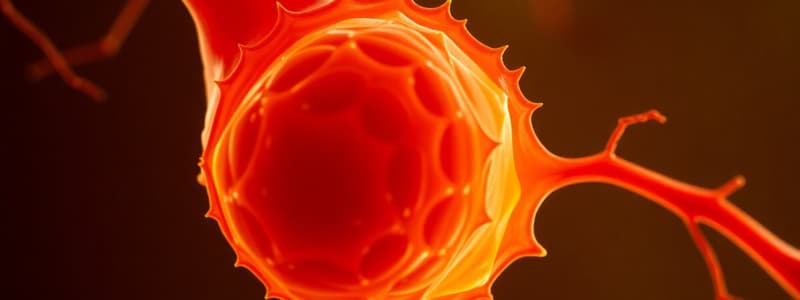Podcast
Questions and Answers
At what stage of follicular development does the antrum first appear?
At what stage of follicular development does the antrum first appear?
- Tertiary follicle
- Secondary follicle (correct)
- Primary follicle
- Primordial follicle
Which structure directly surrounds the oocyte as it is released during ovulation?
Which structure directly surrounds the oocyte as it is released during ovulation?
- Corona radiata (correct)
- Theca interna
- Zona pellucida
- Cumulus oophorus
What is the primary fate of the corpus luteum if pregnancy does not occur?
What is the primary fate of the corpus luteum if pregnancy does not occur?
- It migrates to the fallopian tube.
- It persists through the menstrual cycle.
- It degenerates into a corpus albicans. (correct)
- It transforms into a primary follicle.
Which cells differentiate into the theca interna and theca externa?
Which cells differentiate into the theca interna and theca externa?
What is the primary function of the corpus luteum during the first few months of pregnancy?
What is the primary function of the corpus luteum during the first few months of pregnancy?
Which of these is NOT a key process during follicular development stages?
Which of these is NOT a key process during follicular development stages?
During which stage of meiosis are the oocytes arrested until puberty?
During which stage of meiosis are the oocytes arrested until puberty?
What is the name given to the structure formed immediately after follicle rupture, before the formation of the corpus luteum?
What is the name given to the structure formed immediately after follicle rupture, before the formation of the corpus luteum?
What is secreted by granulosa cells that contributes to the formation of the zona pellucida?
What is secreted by granulosa cells that contributes to the formation of the zona pellucida?
What is the name of the layer of cells connecting the oocyte to the granulosa layer?
What is the name of the layer of cells connecting the oocyte to the granulosa layer?
Flashcards
Oogonia to Oocyte Development
Oogonia to Oocyte Development
The initial stage of female gametogenesis, where germ cells called oogonia differentiate into primary oocytes. This process begins in the sixth week of embryonic development.
Follicular Development
Follicular Development
The development of follicles from primordial to Graafian follicles, encompassing a series of changes and growth encompassing a total of approximately 28 days.
Primordial Follicle
Primordial Follicle
The first stage of follicle development, characterized by the growth of the oocyte and the surrounding granulosa cells.
Primary Follicle
Primary Follicle
Signup and view all the flashcards
Secondary Follicle
Secondary Follicle
Signup and view all the flashcards
Tertiary/Graafian Follicle
Tertiary/Graafian Follicle
Signup and view all the flashcards
Ovulation
Ovulation
Signup and view all the flashcards
Corpus Hemorrhagicum
Corpus Hemorrhagicum
Signup and view all the flashcards
Corpus Luteum
Corpus Luteum
Signup and view all the flashcards
Corpus Luteum Degeneration (non-pregnancy)
Corpus Luteum Degeneration (non-pregnancy)
Signup and view all the flashcards
Study Notes
Gametogenesis in Females
- Female gamete development begins in the sixth week of embryonic life.
- Oocytes are arrested in meiosis I at birth.
- A limited number of oocytes (300-400) mature, due to atresia (cell death).
- Primordial follicles develop into primary follicles.
- Primary follicles transition to multilaminar primary follicles.
- Primary follicles transform into secondary follicles.
- Secondary follicles transform into Graafian follicles.
- The antrum forms, and the granulosa cells proliferate.
- The zona pellucida forms from granulosa cells.
- The theca interna and externa layers develop.
- The corona radiata surrounds the oocyte.
- The oocyte is linked to the granulosa layer by the cumulus oophorus.
- The dominant follicle releases the secondary oocyte.
- Ovulation releases the oocyte into the peritoneal cavity
- After ovulation, the follicle collapses, forming a corpus hemorrhagicum.
Follicular Development
- Several follicles develop, but only one typically ovulates.
- The dominant follicle's granulosa and theca interna cells change after ovulation into the corpus luteum.
Ovulation
- Ovulation releases a secondary oocyte surrounded by corona radiata.
- The dominant follicle ruptures, releasing the oocyte.
- The ruptured follicle collapses and fills with blood, forming a corpus hemorrhagicum.
Corpus Luteum Formation
- Granulosa and theca interna cells develop into the corpus luteum.
- The corpus luteum secretes progesterone and estrogen.
- In non-pregnancy, the corpus luteum degenerates after about 10 days into the fibrous corpus albicans.
- In pregnancy, the corpus luteum persists for about three months, until the placenta takes over endocrine function.
Studying That Suits You
Use AI to generate personalized quizzes and flashcards to suit your learning preferences.




